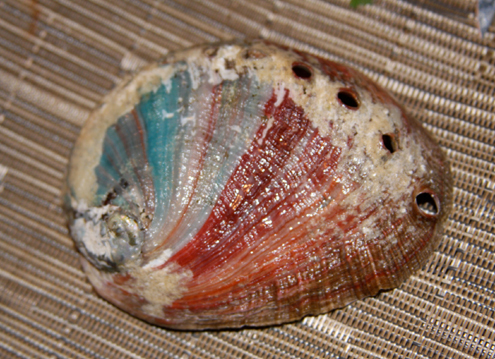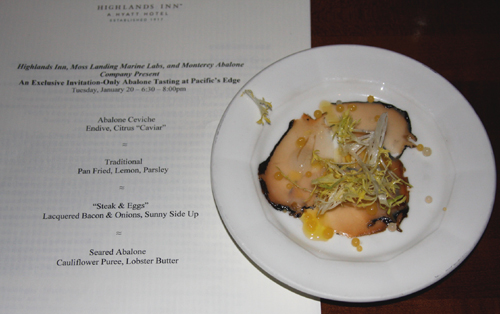Awesome Abalone

Face it, not many of us can sport six-pack abs.
But the Highlands Inn in Carmel can give you “Super Abs” — for a price.
That’s short for abalone that’s farm-raised in a sustainable manner by the Monterey Abalone Company. And these particular ones are ”super” because the red abalone (the most common type raised off California waters) are being cultivated wtih a new method that results in faster growth, a brighter color, and apparently more flavor. (Yours truly has only tasted the “regular” Monterey Abalone Company abalones. And those are mighty fantastic already.)

The abalone company is working in conjunction with Moss Landing Marine Laboratories to do this. Highlands Inn has exclusive rights to all of the “Super Abs” now available to be harvested.
Executive Chef Mark Ayers of the Highlands Inn will be showcasing the abalone in dishes in the hotel’s Pacific Edge and Sunset Lounge through at least the spring. They include: seared abalone with cauliflower puree and lobster butter; abalone ceviche with endive and citrus “caviar”; and “steak and eggs” (abalone with lacquered bacon, onions, and a sunny-side-up quail egg.

Thanks for the info – I’ve only had abalone once, at Manresa. It was quite good!
I remember when abalone was common on menus in the Bay Area (1950s). In those days it was often just pounded, sliced, breaded and panfried—like a schnitzel or scalopini. It was also cheap. Then it was over fished and all of a sudden then was no more. I’ve only had local abalone it one since then.
Sara, you picked a great place to have your one and only abalone. Manresa’s David Kinch knows how to handle that delicate shellfish with care to bring out all its sweet flavor.
Peter, my husband remembers when his brothers used to have piles of abalone shells in the backyard after wading out into the local waters for them. That’s how plentiful they used to be. But you’re right — overfishing destroyed the wild population. The ones you enjoy in restaurants are all farm-raised, by law. You can still catch wild ones, only in season, in limited quantities, and with permits. You just can’t sell them. That, too, is against the law now.
Interesting as usual, Carolyn!
I once cooked at a small San Francisco restaurant (it shall remain nameless… ) that, for special menus, bought black-market abalone from a shady diver. Shameful, but I was too young and clueless to realize how seriously irresponsible the chef was. The diver was as furtive and paranoid as a drug dealer: you’d have to call, let the phone ring in a certain pattern, and wait for him to call you back.
Glad to know a legit market has sprung up since then.
Growing up the only abalone we had came in cans and was served in soup and I didn’t think it was that great. Well, basically it was also cuz it was served in a soup called “tu taw t’ng” (pig’s stomach soup). So I basically didn’t think abalone was that great. Then I came to San Jose and had a brother-in-law who went free diving and caught those limited quantities one and had them fresh with a little lemon juice and fish sauce. Now that was the BOMB!
I’ve never had abalone, but I’d love to know how that tastes! Interesting!
Cheers,
Rosa
My mom used to make abalone pounded, floured and pan-fried and that remains my favorite dish. I sometimes dream about the taste…..
Abalone is easily my favorite food. My family goes abalone hunting a few times a year, so I’ve been spoiled. I usually just pan fry it, but this is inspiring me to play around a little.
John: I picture a scene that’s a cross between something out of “Kitchen Confidential” and the “Sopranos.”
Katie: I envy you your free, ready supply of wild ones.
Annie: I am trying a dash of fish sauce if I ever get my hands on some more farmed abalone to cook at home. A great flavor addition!
Rosa: Raw, sashimi-style abalone has a lovely crunchiness. When cooked, abalone is extremely tender. It tastes a little like a firm, sweet, scallop. If anyone has any better descriptions, please do chime in.
My family ate abalone frequently but I have yet to actually have it myself. I so loved the shells as a child though! I think I’m finally ready for my first experience. What a great place to check it out too!
ooh, I love abalone! Last valentines day I ordered the precious mollusk from the abalone farm and my cooking efforts were completey wasted. We ended up tossing out the rest… For that kind of money, I’ll leave cooking these tiny delicate critters to the professionals.
abalone should be one of the most sustainable farmed seafood, they are slow moving and require little space, they feed off kelp which is plentiful, and there is lots of open space near their natural habitat with pure seawater for eco-responsible farming. yet they are nearly extinct in the wild, disease-ridden (withering disease) and poaching is controlled by criminal cartels. abalone farming has gone nowhere, despite being around for 50 years.
what gives?
seems like the slow growth rates, are the rate limiting factor here. that and the fact that the cartels will find it cheaper to poach than to buy from abalone farms until it becomes truly extinct. plus there simply isn’t a domestic market to support expansion of abalone farms.
Doc Dave: Farmed abalone is absolutely sustainable. I’ve written a couple stories about abalone for the San Jose Mercury News and Via Magazine. California is the only state with abalone farms. It’s not an easy enterprise to start up. The permitting itself can take years for approval. On top of that, abalone grow extremely slowly — an inch a year if you’re lucky. That means a huge investment, and years before you start recouping any of it. That’s also why abalone are so expensive to buy now — about $24 a pound retail. Not that many people are willing to fork out that kind of money these days, even for something as special and wonderful as this. I, too, hope abalone becomes more prevalent in the future, because it would be a shame to see something once so plentiful become accessible only to those with deep pockets.
24 a pound retail is on the shell live weight sale, since they are only slightly easier to dress than sea urchins… for consumer-friendly ready to eat steaks, the retail price is more like 70 bucks a pound. simply exorbitant. the truth is, people motivated to write about this or to think about this are the only ones who care about this.
the economics is messed up. consumers in asia are willing to pay up to 100 bucks a can, yet even at that price, if you do the math, the farm raised product still cannot compete against that of wild-caught (read poached). basically, it is a simple proposition, until they are extinct, there is not much economic incentive to do mass produced farm-raised. so farm-raised has remained a niche market for 50 years. as you noted with all the permit and slow growth, it is a significant upfront investment. there are few farms out there (perhaps only 100 or so in the west) and little competition. people who run abalone farms are mostly sea-grant academic types who are happy to ship live abalone to japan for sashimi. basically no one wins if the price of the abalone drops through farm raising, no one except consumers.
think about it, delicious protein, eco-friendly. yeah, that and nuclear fission.
CJ, I so remember your piece in the S.J. Merc News. I saved that October 10, 2007 feature article and recycle a piece of it here in this excerpt:
=====================
ABALONE FARMING — LIFE IN THE SLOW LANE
SPEED RACER LEARNS PATIENCE IN RAISING PRIZED MOLLUSK
Author: CAROLYN JUNG, Mercury News
Saturday nights at the Petaluma Fairgrounds, Silicon Valley mechanical engineer Doug Hayes indulges his passion for speed, strapping himself into a stock car to burn rubber around a noisy, dirt oval at 100 miles per hour.
Then Sunday mornings, he climbs bleary-eyed aboard his cabin cruiser at Pillar Point Harbor in Half Moon Bay to tackle a different pursuit, one that moves at an excruciatingly glacial pace.
But when you’re the only farmer in Half Moon Bay raising abalone — which grow an inch a year, if that — you learn patience.
A lot of patience.
Hayes started applying for permits to establish the underwater farm when he was 35. This is the first year he began selling the pricey, live delicacy to the public and to a few restaurants. He’s now 50.
”I like speed,” Hayes says, realizing the contradiction. ”Go figure.”
=====================
That sparked me to drive to Half Moon Bay’s Pillar Point and purchase a few small ab–as Doc Dave says–at $24/lb shell-live. Stuff happened that day so I didn’t have time to pound, flour and pan-fry myself so I took the abs to a local (Redwood City) sushi place and, after paying yet another hefty fee, had them prepare the mollusks for my dinner later that evening. It was (surprise surprise) sashimi style and I discovered to my horror that the fresh crunch touted by others in no way equalled the exquisite pleasure I always enjoyed dining on traditional preparation. Clearly my bad.
It also made me bemoan the moving of a next door neighbor, a retired fireman who, used to free-dive for abs, then later, after pounding several in his backyard, would ring my doorbell when we, with not much more than large mutual smiles, he’d hand me a sack of ready-to-fry abs and I’d hand him a few bottles of top-end Chards. I so miss those days!
Wayne: You bring back fond memories for me. That was such a fun story to write. It also was my first experience dealing with live abalone. I drove back home from Half Moon Bay with a couple of them on ice in my trunk. The hubby, aka Meat Boy, did the honors of shucking them, as I admit I was a little squeamish about doing it myself. I’ve shucked oysters and clams before, but never an abalone. We used directions I had gotten from Chef David Kinch of Manresa to pound them lightly, dredge delicately in flour, then saute in butter. Squeeze a little lemon over and you’re good to go. If only I could afford to eat them more often. Absolutely divine!
That’s so sweet about your abalone-diving neighbor. It IS too bad he moved away. What a treat that was to have him share that bounty with you.